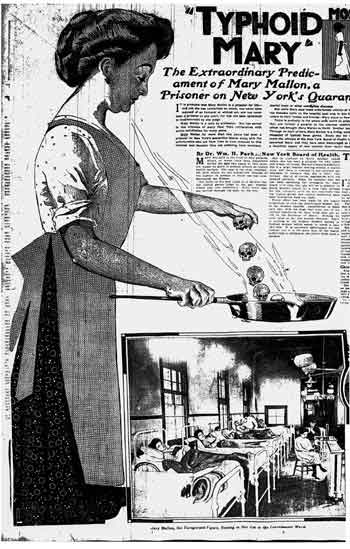The sunset view from the Trump World Tower at United Nations Plaza was magical and dizzying. High above Manhattan, we found ourselves eye-level with a glowing Empire State building. In the distance, the jeweled, twinkling arms of three bridges pointed the way to Brooklyn and Queens. But the lights also drew attention to a shadow in the river—a wooded island that I’d seen countless times before but which now looked especially sad and mysterious. After dinner, the conversation turned to the strange place and its most famous resident.
When Mary Mallon left Ireland at 15 in 1884, she had already survived years of poverty, loss, and disease. Every bout of suffering had brought death to those around her, but seemed to only make Mary stronger. She arrived in the city penniless and determined to make a better life for herself. Instead, she found herself in living in Lower East Side tenements in the same conditions she had struggled to escape back home. Through hard work and determination, Mary fought her way out of poverty by mastering the art of cooking. Gifted and in demand, she soon became a cook for some of the wealthiest families in New York. For twenty years she lived as a prosperous, independent woman in a city that thrilled her.
Unfortunately for Mary, typhoid fever seemed to follow her wherever she went. When the disease, associated in the public mind with slums and tenements, reached a summer estate where she was temporarily employed, it became clear to a hired investigator that Mary was the cause. He discovered that she had infected six out of her previous eight employers. When a child died of typhoid fever in yet another household where she’d recently been employed, Mary was taken to a dismal island in the East River. It was North Brother Island, the very place we spied from high atop Trump World Tower.
Mary was quarantined at North River Island’s Riverside Hospital. Tests seemed to indicate that Mary was a “healthy carrier” of the disease, and she spent the next three years alone in a cottage that faced the exciting city she loved. She passed the time writing angry, indignant letters to the press about the unfairness of her situation. When she was finally released, it was under one condition—that she never return to cooking. Her disease had made her a threat to society.
Mary kept her promise, but with no way of earning an income she was soon broke. She moved back into a tenement and laundered clothes for small wages until she couldn’t take it any longer. Convinced that she was healthy, she accepted a position at (of all places) a maternity hospital. In short order, 25 people contracted typhoid fever and two died of the disease. Mary, now known as ‘Typhoid Mary,” was reinstated at North Brother Island. The hospital staff was friendly toward her, and she was allowed to visit the city once a week. She kept a dog for company, and she lived on that small patch of land in the East River until her death 26 years later, at the age of 69. It is estimated that she infected 47 people with typhoid fever and caused the deaths of three more. North River Island was abandoned in 1963, and today it is a protected nesting area for rare and endangered birds.












Adonia
Very interesting and well written. Thank you.